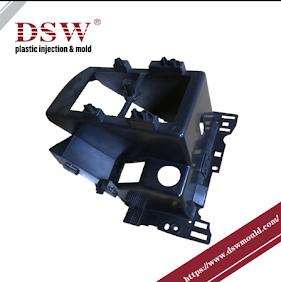The Evolution of Plastic Moulds

Plastic molding is a cornerstone of modern manufacturing,
enabling the creation of many plastic products that touch almost every aspect
of our lives. From high-end electronics to everyday household items, plastic
molding processes have revolutionized the industry in their variety, precision
and efficiency.
Understanding
the plastic molding process:
Plastic molding involves a variety of processes, each
tailored to manufacturing needs and requirements. Injection molding, perhaps
the most common technique, involves injecting a molten plastic material into a
mold cavity under high pressure. This process is suitable for the production of
complex parts in high quality and consistent quality and strict tolerance,
making it important in industries such as automobiles, electronics and consumer
goods. Another important method is molding, where molten rubber is poured into
a hollow tube (parison) and pressed to fit the shape of the mold. This method
is often used to produce bottles, containers and other hollow products,
providing good material distribution and dimensional stability.
Additionally, there is rotational molding, which involves
heating and turning the mold into a mold filled with plastic resin. As the mold
rotates, the plastic sticks to its interior, forming an even layer that hardens
into the desired shape. This method is well suited to the manufacture of large
hollow objects such as tanks, sports equipment and kayaks, due to its low
material cost and structural flexibility. Other popular Plastic molding techniques include thermoforming,
compression molding, and extrusion molding, each with unique advantages and
applications. Collectively, these techniques help manufacturers to create a
variety of plastic products, from complex objects to large structures, with
precision.
The
innovation behind plastic molding:
The field of plastic molding is constantly changing,
promoting innovation in materials, technology and manufacturing processes. A
significant advance is the combination of computer-aided design (CAD) and
computer-aided manufacturing (CAM) software, which allows manufacturers to
create complex molding designs and streamline production processes.
unprecedented. This digital marketing capability enables rapid prototyping,
design optimization, and ultimately shorter time to market for new products.
In addition, advances in materials science have expanded the
palette of plastics available for molding, through the development of advanced
polymers, biodegradable resins and recyclable materials. These innovative
materials offer improved performance, improved durability and greater
flexibility, opening up new opportunities for product development across
industries.
Automation and robotics have also transformed the plastic
molding industry, streamlining production processes, improving efficiency and
ensuring consistent quality. From robotic part handling and assembly to mold
change systems and automation, these technologies help manufacturers achieve
higher results, reduce labor costs and maintain quality control standards.
In addition, additive manufacturing, commonly known as 3D
printing, is increasingly entering the plastic molding process, offering rapid
prototyping, tooling production and even final part production. Although it is
still in the early stages of mass production, 3D printing has great potential
to revolutionize the way plastic products are manufactured, especially for
small volume, highly customized applications.
Applications
in all categories:
The evolution of plastic molding techniques has led to their
adoption in many industries, each with its own unique requirements and
challenges. In the automotive sector, plastic molding plays an important role
in the production of interior and exterior components, insulation parts and
structural components that contribute to vehicle safety, performance and fuel
efficiency. From dashboard panels to bumpers to intake manifolds, plastic
materials abound in modern cars, due to their light weight, cost-effectiveness
and structural flexibility.
Apart from automobiles, electronics and packaging, Injecton moulding finds applications in the aerospace, healthcare,
construction and consumer goods industries, among others. From airplanes and
medical devices to building materials, toys and electronics, the impact of
plastic molding on modern life is widespread and profound.
Important
support:
Although plastic molding has revolutionized the industry and
made our lives better, it also poses major environmental problems, especially
when it comes to plastic waste and pollution. As the world worries about the consequences
of single-use plastics and plastic pollution in oceans and landfills, the need
for support in the plastics industry is on the rise. In response to these
challenges, there is an increasing focus on sustainable practices and materials
in the plastic molding industry. Manufacturers are increasingly using recycled
plastics, bio-based resins and biodegradable polymers to reduce reliance on
virgin plastics and reduce their impact on the environment. In addition,
initiatives such as closed recycling, extended producer responsibility (EPR)
and eco-design principles are gaining traction, driving innovation and collaboration
across the spectrum.
In addition, advances in recycling technologies, such as
chemical recovery and recycling, promise to transform plastic waste into
valuable raw materials for new products, thus closing the loop and creating a
circular economy for plastics. By supporting sustainability, manufacturers can
not only reduce environmental damage, but also improve their reputation, meet
regulatory requirements and in the future present their business in an
increasingly environmentally conscious market.
Conclusion:
Plastic molding is a testament to human ingenuity and
innovation, helping to create many amazing plastic products that improve our
lives in so many ways. From automotive components to electronics to everyday
necessities, plastic molding techniques have become essential in modern
manufacturing, offering unparalleled flexibility, efficiency and cost. As the
field continues to grow, thanks to the advancement of materials, technology and
support strategies, the future of plastic molding holds great promise for meeting
global challenges and making positive changes. By fostering innovation,
adopting sustainable practices, and fostering collaboration across industries,
plastic molding can continue to advance human prosperity while reducing its
environmental footprint, enabling a better, sustainable future for generations
to come.


Comments
Post a Comment